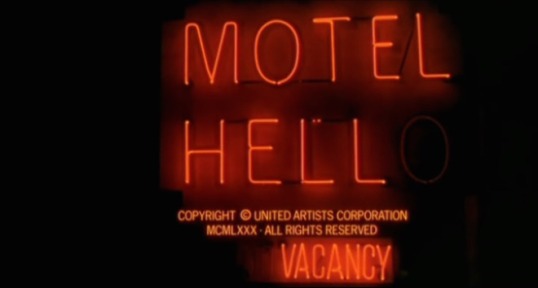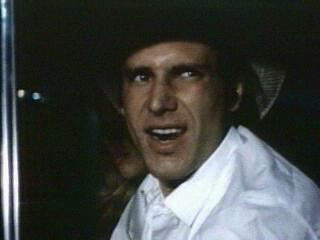You read the title of this post correctly. This is directed by Kevin Connor who has made numerous Hallmark films I’ve reviewed on this site. In addition, Bradford May was the camera operator on this film who also went on to direct numerous Hallmark movies I’ve reviewed. And it has one more connection to Hallmark because it has John Ratzenberger in it who went on to be in a few Hallmark movies.
So with all those connections to Hallmark in this 80s horror film, does it have any similarities to those films? Actually, it does in a way. In the case of Kevin Connor, it makes sense to hire a director who has proven themselves to be able to make a memorable movie with a small budget to make your small TV Movies.
Let’s talk about the movie now.
The film opens with Vincent Smith (Rory Calhoun) sitting on the porch of his Motel Hello. The ‘O’ being in need of replacing as it keeps going out. Thus changing the name of the place to Motel Hell. Smith drives out to the road and we see a motorcycle carrying a guy and a girl go past a sign.
Smith sells smoked meat out of his motel. He sees the motorcycle hit something then go down. The guy is dead, but the girl is still alive. He loads them up and brings them back home.
Smith doesn’t live alone. He lives with his sister Ida (Nancy Parsons). Look familiar?
If a painful game of tug of war came to mind, then you do recognize her, because that’s Balbricker from Porky’s (1981). She grabs no dicks in this movie. This is Rory Calhoun’s film. And he makes it known with his time tested and approved way of calming kids down who just ran scared after wandering through a slaughterhouse.
We are now introduced to the three other characters who matter in this movie.
First, the girl who survived the crash. Her name is Terry (Nina Axelrod). She wakes up to find out that her boyfriend is long gone. Smith has already buried him.
Second, the 80s sheriff Bruce Smith (Paul Linke). He’s Vincent Smith’s kid brother.
And inspector Bob Anderson (E. Hampton Beagle). Oh, poor poor Bob. Because after he gets this goodbye from Vincent.
Bob makes an unfortunate discovery about Vincent’s secret garden.
Yep, Vincent’s meat comes from people. Let me try and explain it the best I can. He sets traps on the nearby road so that people crash. He goes in and gasses them. He then takes them back to his secret garden and slits their vocal cords. He then plants them in the ground leaving just their head poking out. That’s why when the bag covering their heads are pulled off they just making groaning almost zombie like noises. Then he appears to hypnotize them using colorful pinwheels and hypnotic noise before he snaps their necks with a noose attached to a tractor trailer. They are then turned into the meat that he sells. Rather gruesome, but there honestly isn’t a whole lot to it. Here’s the scene that basically sums it all up.
Luckily, one of those heads is attached to John Ratzenberger. I say luckily because it means we finally all got our wish. Cliff Clavin has no way to tell his annoying stories anymore.
Oh, and Ratzenberger is captured after a van carrying himself and several bandmates hits a trap laid by Vincent. And you know what? More bands need to be named after Sergei Eisenstein movies.
That’s basically the film right there. Vincent and Ida collecting bodies, feeding the heads, and justifying it all to themselves with crazy talk. Then Bruce and Terry eventually figure things out and the net closes in on them.
There is one particular capturing scene that is worth watching. Here’s the capture of the kinky couple.
The other thing that is worth mentioning is that Wolfman Jack is in this. He plays a reverend.
According to Motel Hell, the lord works in mysterious ways. Sometimes the lord provides you with an excuse to confiscate a copy of Hustler for your own personal collection.
Horror really isn’t my thing and this film does begin to wear out it’s welcome at a certain point, but it’s Calhoun’s performance and the creepy atmosphere that makes it work. There are more clips up on YouTube if you want to see more in order to make your decision about watching this or not. I guess you have my recommendation.





















